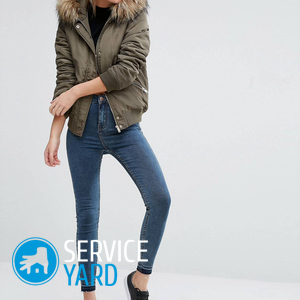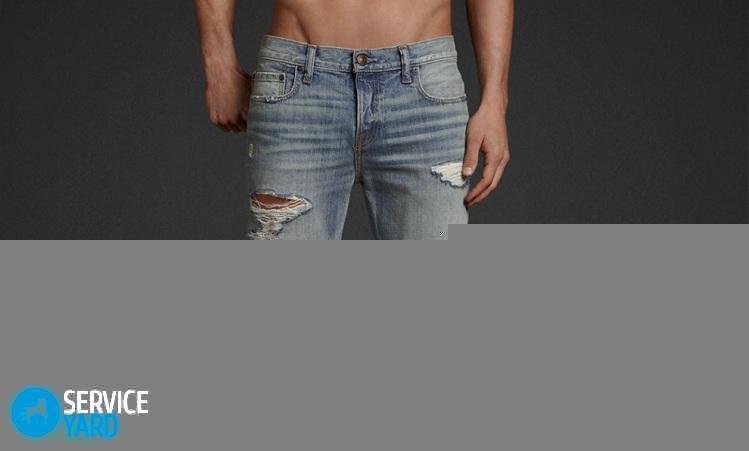What are jeans made of?

Absolutely every person in the wardrobe has at least one thing made of denim. Things made from such material have been popular among consumers for decades. Not only shirts and trousers are sewn from denim material, but also some decor elements (pillows, toys and even panels). Surely any owner of pants made of such fabric wondered: what are jeans made of? In order to understand this issue, you should familiarize yourself with the types of this material, its features and properties.
to contents ↑Denim Production
In order to make denim (jeans), several types of raw materials are used. The appearance, features and properties of the fabric depend on it:
- Asian cotton - is considered one of the most common types of raw materials for creating denim. It has fairly long fibers, so many call it short-staple.
- Mexican cotton - products from this product are smooth and a little shiny. It is very difficult to notice any flaws and scars on them.
- Zimbabwean cotton - considered the best option for the ratio of quality and value. At an affordable price, it can compete with better and more reliable raw material options.
- Barbados cotton - very rarely used for sewing jeans. Its texture is very soft and pleasant to the touch. However, only 7% of products from such raw materials are represented on the market.
Important! What other fabric are jeans made of? A huge number of different clothes are sewn from raw denim. It is considered as natural as possible, with a natural color.
Consider the process of manufacturing denim clothes:
- Cotton preparation. It is first collected and then cleaned manually or automatically. This stage includes the process of cleaning, loosening and mixing.
- Spinning. The procedure begins from the moment the cotton was turned into long, thick threads. They are twisted until it is possible to make thin strings from which tissue will subsequently form.
- Staining. The resulting yarn is stained with a natural dye - indigo. Recently, however, they have begun to use an artificial alternative to natural dye. Artificial paint lays more evenly.
- Creation of fabric. Usually a fiber to 3 ratio of 1 is used. In the manufacture of the fabric, shuttle and shuttleless mechanisms are used, depending on what type of fabric is created and what fabric it is planned to make jeans from.
- Treatment. When processing the material, the manufacturer can compose it or carry out other manipulations that will subsequently affect the appearance and properties of the fabric.
Having familiarized yourself with the above basics of production, you will already have an idea of what material jeans are made of.
to contents ↑Types of jeans material
Thanks to the intensive development of technology, jeans are made not only in one rough form. Its varieties are quite numerous:
- Denim - is one of the most expensive and high-quality materials. The main feature is that products from such matter are white on the underside and bluish on the front. This fact is determined by the unilateral dyeing of the fabric. To date, denim has undergone many neoplasms, but still remains a reliable and durable material.Now designer clothes are sewn from him, which costs a lot of money.
- Gin - this is the same jeans, but with its own characteristics. It is considered one of the cheapest and finest materials. It is made from the binding of two threads of cotton fabric.
- Broken twill - in another way it is also called “chevron”. The interweaving of twill fabric is characterized by a unique pattern. The denser and thicker the fabric, the more diverse the patterns on it can be.
Important! Twill material has a herringbone pattern. The first jeans made of such fabric were sewn in 1964.
- Stretch - a combination of synthetic (elastane) and natural (cotton) fabrics. Most often women’s clothing is sewn from such a fabric, as it perfectly fits the figure.
- Eikra - is a raw jeans. It has the color of ordinary cotton fabric.
- Chambray - is the thinnest denim. From it sew linen, swimwear and summer clothes. Its feature is that the fibers are intertwined in a ratio of 1 to 1.
Differences in appearance
In appearance, jeans are divided into four groups:
- Vintage jeans - in another way they call it “dumpling”. It is characterized by characteristic scuffs and several bleached areas on the product.
- Designer jeans - things sewn from this type of fabric are considered quite provocative and vibrant. When sewing, additional elements are used, such as golden threads, inserts.
- Striped - characterized by stripes on matter. They can be barely noticeable on the product or catch your eye.
- Luxury - in appearance resembles expensive costume material. It has a barely noticeable luster and a uniform surface.
If you decide to sew trousers yourself, then in the stores of materials and accessories they will tell you which fabric is better to make jeans from.
to contents ↑Pros and Cons of Denim Material
Consider the main advantages and disadvantages of this material. Let's start with the pros:
- Strength. No matter what kind of weave the material has, it has high strength indicators. However, for summer jeans clothes this criterion is minimized.
- Breathability - provided by natural raw materials (cotton).
- Wear resistance - a high-quality denim product can last more than 10 years with proper care.
- Beautiful appearance - due to the different types of finishes and patterns on the fabric.
- It is not electrified - due to the fact that the basis of the material is natural raw materials (cotton).
- Almost no creases.
- Able to protect from extreme heat and wind.
- Pretty easy to clean (wash, iron, wear).
Consider the main disadvantages:
- Rough fabric. Especially if it does not include synthetic fibers.
- When re-worn, the product shrinks.
From all the above, we can conclude that the advantages of jeans material are much more than disadvantages. That is why products from this fabric are popular among consumers of all ages.
to contents ↑Jeans Care
In order to extend the life of your favorite jeans and maintain their beautiful appearance, you need to properly care for them. Consider several recommendations for care:
- Do not wash clothes with white items, as they may fade.
- Pay attention to the clothing label - it indicates the temperature of the wash.
- Do not use “White” and chlorine-based detergents when washing.
- It is advisable to let the wet product drain. Squeezing is not recommended.
- Ironing is necessary only from the wrong side. If you decide to iron on the front side, use an additional piece of fabric.
Stock footage
By following these few simple rules, you can keep your jeans beautiful for many years, as if you had just bought them. And information on what jeans are made of will help to understand a little about the fabrics and the quality of the proposed product when buying.
- How to choose a vacuum cleaner taking into account the characteristics of the house and coatings?
- What to look for when choosing a water delivery
- How to quickly create comfort at home - tips for housewives
- How to choose the perfect TV - useful tips
- What to look for when choosing blinds
- What should be running shoes?
- What useful things can you buy in a hardware store
- Iphone 11 pro max review
- Than iPhone is better than Android smartphones




